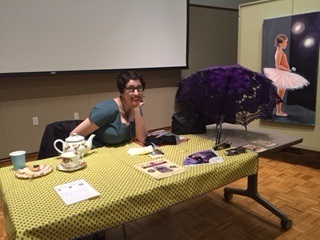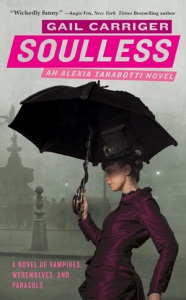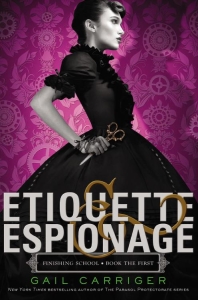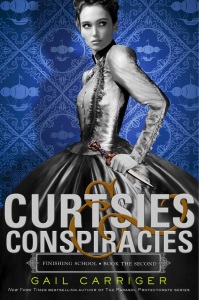Fashion-Forward Vampires and the Power of Humor in Genre Fiction
Them: Oh hello, what is it you do?
Self: I’m a writer.
Them: That’s cool, what do you write?
Self: Commercial genre fiction. You know, science fiction, fantasy, romance, young adult.
*Pause.*
Self: It’s mostly funny.
 Gail Carriger at the Brookline (MA) Public Library in 2014. Photo: Elissa Gershowitz.
Gail Carriger at the Brookline (MA) Public Library in 2014. Photo: Elissa Gershowitz.So. Hello. My name is Gail Carriger. I’m an author. And I’m addicted to comedy.
I’ve written several series set in an alternative Victorian society where fashion-forward vampires, grumpy werewolves, humans, ghosts, and the occasional librarian commingle. When my first book, Soulless, came out, I joked that it was an “everything but the kitchen sink” piece of genre fiction. The spine said “fantasy horror,” the pink cover said “romance steampunk,” the back-cover blurb said “funny alt-history.” Few noticed I was borrowing a hell of a lot of tropes from the Gothics. Some accused me of secretly being a mystery author. When I moved on to YA, I added spy adventure and thriller into the mix. But what I’ve always focused on, and what I’ve tried to do more than anything else, seems pretty darn simple: make readers smile.
Turns out that is a rather challenging and complicated thing to do. And here I’m going to challenge myself more by writing about writing comedy. Explaining how comedy works and what it can do is a little like watching one of those cooking shows, a frustrating tease. It destroys the magic, knowing how something gets made, and you still don’t get to eat it when it’s finished. I won’t be giving you a how-to lesson on sticking humor into prose; there are plenty of others out there happy to teach you how to write. I’d rather talk about what it can do, because comedy is immensely useful.
The Semantics of Funny Business
The bowl landed, in glorious perfection, atop the head of Mrs. Barnaclegoose, who was not the kind of woman to appreciate the finer points of being crowned by trifle. —Etiquette & Espionage
 Can I get something out of the way first? By humor I mean a great deal more than a sassy, angst-driven, pixie dream girl vomiting forth her quirky first-person perspective on life’s current tragedy. Humor can be anything from puns, to twisted sentences, interjected narration, (overly) complex world building, witty dialogue, ludicrous situations, absurd exaggeration, slapstick, contrast, and oddball perspectives on the past, present, or future.
Can I get something out of the way first? By humor I mean a great deal more than a sassy, angst-driven, pixie dream girl vomiting forth her quirky first-person perspective on life’s current tragedy. Humor can be anything from puns, to twisted sentences, interjected narration, (overly) complex world building, witty dialogue, ludicrous situations, absurd exaggeration, slapstick, contrast, and oddball perspectives on the past, present, or future.I try to use as many of these aspects as possible in my own writing: shifting from exaggeration, to malapropisms, to farce, to parody, and ending with a crazy description of a particularly peculiar hat. This keeps readers interested, occasionally surprises them, and on a purely mercenary level allows for foreign translations without losing all aspects of humor. Slapstick, for example, transcends most cultural barriers; wordplay, however, does not. (Trying to explain my ridiculous invented words and why they are funny in a Victorian setting to my Japanese translator using the comparative class structures of shogunate Japan was an unexpected side effect, and amusing in its own right.)
What people can lose sight of amidst the apparent frivolity is that humor, at its most basic, is a tool. A very powerful one.
World-Building & Description
He was very pale and boasted an unassuming mustache, which was perched atop his upper lip cautiously, as though it were slightly embarrassed to be there and would like to slide away and become a sideburn or something more fashionable. —Etiquette & Espionage
I come to authorship via archaeology, which means that the objects and settings of my universe are almost as important as my characters. Perhaps better put, I never forget how much impact place has on my people. Their world, the spaces they inhabit, and the things they interact with represent them, and influence and are influenced by them. Perhaps this also ties to my love of Gothic novels, where setting is character (especially when combined with a reliance on metonymy).
What this means is that the world itself is also a rich source of humor. For example, I put vampires in charge of my Victorian society, including fashion. Which means that the real-life Victorians’ ubiquitous heavy velvet curtains to keep out sunlight, the admiration for pale skin, and the insistence on high collars and cravats all make perfect sense in my series. Also, new vampires with new teeth are going to lisp—have you ever worn fake fangs? I rest my case.
As a writer, this allows me to talk about the world around my characters and relay information to my readers about how my Victorian era is different from the real one but in an entertaining and engaging way. One of the great trials of writing fantasy, sci-fi, or alt-history is getting information across to the reader without coming off as dull or lecturing. (We call this info-dumping.) Humor can be a means to this very necessary end, showing readers how things are different (without actually telling them) and making them chuckle along the way.
Characters & Silences
“What’s that?” she asked the girl, wrinkling her nose.
“Oh, that? That’s just Pillover.”
“And what’s a pillover, when it’s at home?”
“My little brother.”
“Ah, I commiserate. I have several of my own. Dashed inconvenient, brothers.”
—Etiquette & Espionage
 At root, I invest most of my funny in my characters. This is because my books are character (not concept) driven. It’s also because I seek inspiration in my own friendship group, which is a pretty hilarious crew, all told. The absurdities of my own high-school experience informed my YA series, even though they were separated by hundreds of years and thousands of miles.
At root, I invest most of my funny in my characters. This is because my books are character (not concept) driven. It’s also because I seek inspiration in my own friendship group, which is a pretty hilarious crew, all told. The absurdities of my own high-school experience informed my YA series, even though they were separated by hundreds of years and thousands of miles.Comedy has an interesting effect on characterization. I’ve found that it is often my most humorless characters that readers are most amused by. Amidst all the drama-attracting protagonists, empty-headed social climbers, and flamboyant vampires, it’s the grouchy ones, and the glum ones, and the ones who have very little to say who draw attention by contrast (examples from my YA series include the aforementioned Pillover; Sidheag Maccon, a dour Scottish girl raised by werewolves; and a small mechanical dog named Bumbersnoot). It is the quiet darkness many readers end up gravitating toward, like grumpy black holes sucking them in.
It is often what these characters don’t say in any given situation that gets the most laughs. Whether sitting in silent judgment or just plain missing the point, these characters often find themselves cast as stooges to those around them.
Humor & Narrative Structure
“I do not giggle without purpose. Lady Linette says you should never misapply a giggle.” —Etiquette & Espionage
Comedy is part of the heartbeat of a book, as much as any action sequence or romantic moment. It can be used to relax a reader right before delivering a strong narrative punch, thus making that punch all the more powerful. It can also be used to break tension, giving the reader some breathing room. Many authors develop a singsong tone to their prose in their choices, intentional or not, of sentence and paragraph structure, even length of words and the order in which they follow each other. This is often exactly what a reader desires from her author’s voice, but it can also lull her into a kind of listlessness. Waking her up with a shake of laughter means that suddenly she is once more paying close attention to the text.
From a mechanical perspective, comedic moments in prose are instruments of pace. A reader will forgive many things if you make her laugh. For example, a long, drawn-out description necessary for world-building is easy to digest when there are two points of connected titillation that yields up a laugh at the end.
Dancers have a saying that the moment you are standing still on a stage is as important (if not more so) than the movements before and after. Whether the funny parts of a book come from its movement, or whether they make up the still points in between, it is the difference that readers are picking up on, and it is the contrast that will leave the most lasting memories and have the most profound effect.
My favorite moments of comedy are the long interwoven ones that come with plot, world-building, and character. I imagine my reader laughing out loud and a friend asking, “What’s so funny?” The reader would have to describe the whole book, or the entire world, or a character’s background for the hilarity to be understood. I call these “you kinda had to be there” jokes.
This type of humor is usually instrumental in defining a book as comedic. Authors of most types of fiction use some form of humor at some point, even if only a bit of witty dialogue. Funny things can happen in suspense, mystery, romance, science fiction, and fantasy. But in “serious” novels humor becomes the high note, an unexpected bright spot, that gives the reader a point of uplift, a chance to catch her breath. Comic authors tend to run the opposite pattern — the story runs brighter and lighter so that the readers’ pause for breath (from laughter!) is actually in a moment of sadness or poignancy. But much as the humor is more stark in a generally darker book, that moment of sadness can be more striking and have a greater impact on readers in a generally funny book.
Subversion
All the best geniuses are evil. —Curtsies & Conspiracies
 Which leads me to my point. Oh yes, I have one. If you take nothing else from this, please realize that comedy is a tool, and one that can have a profound impact on readers. As a culture, we are tempted to dismiss funny things; after all, it is hard to take humor seriously. Because comedy is so easily overlooked, it becomes all the more useful. One has only to look at American sitcoms and the way they have, over the years, altered the perception of what it means to be an American family, from The Brady Bunch to the aptly titled Modern Family. Yes, in some ways these shows played catch-up to the real world, but in other ways they normalized changing values to generations. Hidden behind laughter is possibility.
Which leads me to my point. Oh yes, I have one. If you take nothing else from this, please realize that comedy is a tool, and one that can have a profound impact on readers. As a culture, we are tempted to dismiss funny things; after all, it is hard to take humor seriously. Because comedy is so easily overlooked, it becomes all the more useful. One has only to look at American sitcoms and the way they have, over the years, altered the perception of what it means to be an American family, from The Brady Bunch to the aptly titled Modern Family. Yes, in some ways these shows played catch-up to the real world, but in other ways they normalized changing values to generations. Hidden behind laughter is possibility.You see, the secret is: what’s funny can become what’s normal. Laughter and relaxation can become belief and hope and understanding in a way that slides around harshness and anger. As an author, I want my books, first and foremost, to leave readers smiling, using all the tricks of semantics, world-building, character, pacing, etc. But if my books also leave readers more accepting of the differences that can be found in themselves and others, then the comedy has really done its job.
From the May/June 2017 issue of The Horn Book Magazine: Special Issue: Humor. For an interview with Gail, click here.
RELATED
ALREADY A SUBSCRIBER? LOG IN
We are currently offering this content for free. Sign up now to activate your personal profile, where you can save articles for future viewing.







Add Comment :-
Be the first reader to comment.
Comment Policy:
Comment should not be empty !!!